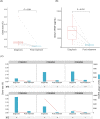Detection of clonal plasma cells in POEMS syndrome using multiparameter flow cytometry
- PMID: 38710832
- PMCID: PMC11074311
- DOI: 10.1038/s41598-024-61034-1
Detection of clonal plasma cells in POEMS syndrome using multiparameter flow cytometry
Abstract
POEMS syndrome (polyneuropathy, organomegaly, endocrinopathy, monoclonal protein [M-protein], and skin changes) is a rare systemic disorder characterized by various symptoms caused by underlying plasma cell (PC) dyscrasia. Detection of monoclonal PCs is mandatory for the diagnosis of POEMS syndrome; however, the usefulness of EuroFlow-based next-generation flow cytometry (EuroFlow-NGF) in POEMS syndrome for detecting monoclonal PCs in bone marrow (BM) and the gating strategy suitable for flow cytometry study of POEMS syndrome remain unknown. We employed EuroFlow-NGF-based single-tube eight-color multiparameter flow cytometry (MM-flow) and established a new gating strategy (POEMS-flow) to detect the monoclonal PCs in POEMS syndrome, gating CD38 broadly from dim to bright and CD45 narrowly from negative to dim compared to MM-flow. MM-flow detected monoclonal PCs in 9/25 (36.0%) cases, including 2/2 immunofixation electrophoresis (IFE)-negative cases (100%). However, POEMS-flow detected monoclonal PCs in 18/25 cases (72.0%), including 2/2 IFE-negative cases (100%). POEMS-flow detected monoclonal PCs with immunophenotypes of CD19- in 17/18 (94.4%). In six cases where post-treatment samples were available, the size of the clones was significantly reduced after the treatment (P = 0.031). POEMS-flow can enhance the identification rate of monoclonal PCs in POEMS syndrome and become a valuable tool for the diagnosis of POEMS syndrome.
Keywords: EuroFlow; Immunophenotype; Multiparameter flow cytometry; POEMS syndrome.
© 2024. The Author(s).
Conflict of interest statement
HT received research funding and consulting fees from SRL, Inc. The remaining authors declare no competing financial interests.
Figures



References
-
- Cook G, et al. High-dose therapy and autologous stem cell transplantation in patients with POEMS syndrome: A retrospective study of the Plasma Cell Disorder sub-committee of the Chronic Malignancy Working Party of the European Society for Blood and Marrow Transplantation. Haematologica. 2017;102:160–167. doi: 10.3324/haematol.2016.148460. - DOI - PMC - PubMed
-
- Suichi T, Misawa S. Polyneuropathy, organomegaly, endocrinopathy, monoclonal gammopathy and skin changes syndrome: Diagnosis, treatment and the current status in Japan. Clin. Exp. Neuroimmunol. 2020 doi: 10.1111/cen3.12560. - DOI
Publication types
MeSH terms
LinkOut - more resources
Full Text Sources
Research Materials
Miscellaneous

